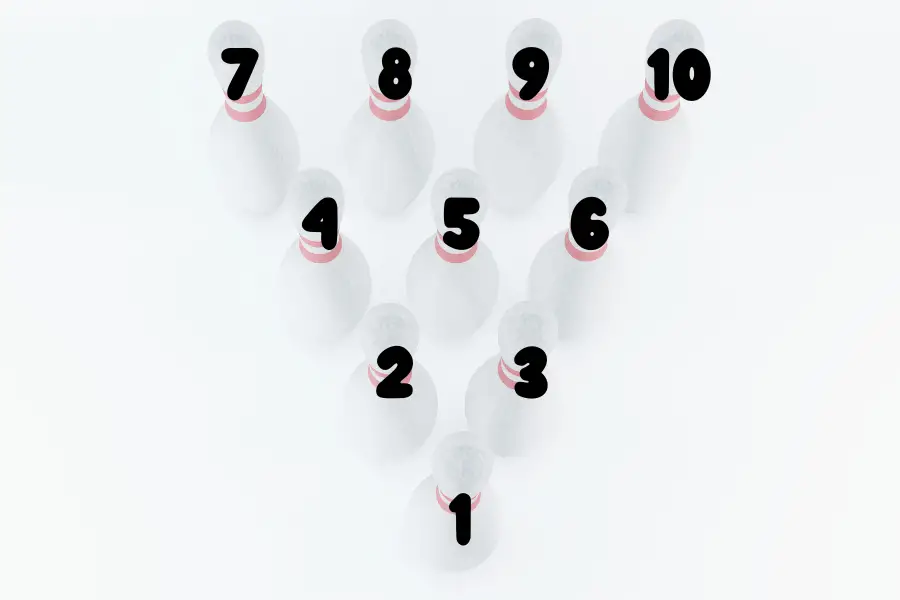
Introduction
Welcome to the fascinating world of bowling where even the smallest detail can make a significant impact on your game. Bowling pins are numbered, based on their position. In tenpin bowling, the bowling pin numbers refer to the position of the pins when they are set. The pins themselves are not actually numbered!
Each pin from 1 to 10 carries its unique identity and value, influencing how you aim, score, and strategize throughout the game. These numbered warriors bring consistency into gameplay while paving a clear pathway for strikes and spares.
Are you ready to improve your technique by mastering these numbered soldiers? Let’s roll!
Key Takeaways
- Bowling pin numbers serve a crucial role in scoring accuracy, fair competition, and consistency in gameplay.
- The sequential numbering system from 1 to 10 allows bowlers to develop targeted strategies, easily identify strikes or spares, and score accurately.
- Understanding the numbering system helps bowlers aim for specific pins based on their strategy and calculate scores more accurately.
- Easy identification of numbered pins enhances gameplay by providing clear targets for bowlers.
The Importance Of Bowling Pin Numbers
Bowling pin numbers are crucial for ensuring scoring accuracy, fair competition, and consistency in gameplay.
Overview Of Pin Numbering System
In the intriguing world of bowling, mastering the pin numbering system is a crucial step for both beginners and experienced players. This system is not merely an arrangement technique but serves as a strategic guide that influences your gameplay decisions.
An intricate look at this system reveals a well-structured layout. At the forefront stands solitarily our brave headpin numbered ‘1’, serving as your primary target on every roll.
Behind it are rows of fellow pins forming a symmetrical triangle: pins 2 and 3 form row two; pins 4,5 and 6 complete row three; while four stalwarts – pins 7 through 10 occupy back line of defense.

Scoring Accuracy And Fair Competition
Scoring accuracy and fair competition are essential aspects of any bowling game. The numbering system of bowling pins plays a crucial role in achieving these objectives.
The sequential numbering of the pins allows for consistent gameplay across different lanes and alleys. It ensures that every pin has a specific value assigned to it, allowing bowlers to calculate their scores accurately based on the pins they knock down.
Imagine playing without numbered pins – it would be difficult to know how to discuss which pins were knocked down, and which ones are left standing.
Moreover, the evolution of pin numbering systems over time has contributed significantly to scoring accuracy. By assigning numbers from 1 to 10 in a specific sequence, it becomes easier for both players and officials to identify which pins were knocked down during each roll.
In conclusion, having clearly numbered bowling pins not only ensures scoring accuracy but also promotes fair competition among bowlers.
Consistency In Gameplay
Consistency in gameplay is crucial when it comes to bowling. And one key factor that contributes to this consistency is the numbering system of bowling pins.
For example, imagine if the numbering system was random or inconsistent. It would be challenging for bowlers to determine which pin they need to aim for in order to achieve a certain score or knock down multiple pins at once.
Additionally, with a consistent numbering system, players can easily communicate with each other about specific pins during team games or competitions.
Moreover, a standardized numbering system allows for better comparison of scores across different games and tournaments.
In conclusion, by maintaining consistency through a well-defined numbering system, bowling becomes more than just knocking down pins; it becomes an art form where skillful players can strategize effectively based on the numbers assigned to each pin.
Evolution Of Pin Numbering Systems
Throughout the history of bowling, pin numbering systems have gone through various evolutions. The early days of bowling saw pins without any numbers, which led to confusion and inconsistent scoring.
One significant evolution in pin numbering systems was the introduction of sequential numbering. This system assigns a unique number to each pin, with the headpin always being number 1.
The remaining pins are then numbered sequentially from 2 to 10.
An example of how this system is applied can be seen in ten-pin bowling, where you typically find a triangular formation of pins at the end of the lane. The back row includes pins numbered 7 to 10, while the middle row consists of pins numbered 4 to 6.
In conclusion, understanding the evolution of pin numbering systems provides valuable insights into the development and standardization that has taken place within bowling over time.
How Bowling Pins Are Numbered And Why
Bowling pins are numbered in a specific sequence, starting with the headpin as number 1, followed by the remaining pins in consecutive order. Understanding this numbering system is crucial for scoring accuracy and strategic gameplay.
Headpin As Number 1
The headpin, also known as the number 1 pin, is an important element in bowling. It serves as the primary target for bowlers and is positioned at the front of the pin setup.
When setting up for a shot, bowlers aim to hit the headpin directly or make contact with adjacent pins in order to increase their chances of achieving a strike or spare.
Understanding the significance of the headpin as number 1 provides bowlers with valuable insights into gameplay strategies and scoring accuracy.
Sequential Numbering Of Remaining Pins
After the headpin, which is numbered 1, the remaining pins are numbered sequentially from 2 to 10. Here’s a breakdown of the sequential numbering system for bowling pins:
- Pin Number 2: Located to the right of the headpin.
- Pin Number 3: Positioned to the left of the headpin.
- Pin Number 4: Found behind and slightly to the right of pin number 2.
- Pin Number 5: Placed behind and slightly to the left of pin number 3.
- Pin Number 6: Positioned between pins number 4 and 5 in the middle row.
- Pin Number 7: Located behind and slightly to the right of pin number 4.
- Pin Number 8: Positioned behind and slightly to the left of pin number 5.
- Pin Number 9: Found behind pins number 7 and 8 in the back row.
- Pin Number 10: Placed at the far-right position in the back row.
By numbering each pin in sequence, bowlers can easily identify specific pins during gameplay. This numbering system also plays a crucial role in scoring accuracy and strategy development. Bowlers can aim for specific numbered pins to increase their chances of achieving strikes or spares.
Note that different types of bowling may use a varying number of pins. Ten-pin, Candlepin, and Duckpin bowling all use ten pins, while Nine-pin bowling only uses nine pins.
Remembering how each pin is numbered can help bowlers better understand and improve their game.
Impact On Scoring And Strategy
Understanding the impact of bowling pin numbers on scoring and strategy is crucial for any bowler looking to improve their game.
The numbered pins provide a clear target for bowlers, allowing them to aim for specific pins based on their strategy. For example, if a bowler wants to achieve a spare by knocking down just two pins, knowing the exact numbers helps them focus their shot precisely on those pins.
In terms of scoring, each pin knocked down carries its own value. By identifying which numbered pins have been hit, bowlers can accurately calculate their scores and adjust their approach accordingly.
Moreover, understanding how bowling pin numbers impact gameplay allows bowlers to develop unique strategies for challenging lane conditions or when faced with tricky spares.
They can analyze previous shots and adjust their aim based on which numbered pins were left standing during previous attempts.
By appreciating the significance of bowling pin numbering systems and actively incorporating this knowledge into their game plan, bowlers can enhance both scoring accuracy and strategic decision-making abilities.
Easy Identification Of Numbered Pins
Easy identification of numbered pins is an essential aspect of bowling. By having the pins clearly numbered, bowlers can easily identify their targets and adjust their shots accordingly.
For example, let’s say you’re facing the 7-10 split, which is widely considered one of the most challenging shots in bowling.
Additionally, numbering allows bowlers to communicate more effectively with teammates and coaches during practice sessions or competitions.
Overall, easy identification of numbered pins streamlines gameplay and enhances accuracy on the lanes.

Bowling Pin Setup And Placement
Bowling pin setup and placement involves carefully numbering and positioning the pins on the lane for optimal gameplay. Understanding the layout and numbering system is crucial to achieving higher scores and improving your bowling technique.
Numbering And Placement Of Pins On The Lane
The numbering and placement of pins on the bowling lane play a crucial role in the game of bowling. Here are some important points to understand:
- Each pin is assigned a number from 1 to 10, with the headpin being numbered as 1.
- The remaining pins are sequentially numbered from 2 to 10, creating a consistent system for identification.
- The pins are set up in a triangular formation on the lane, with the headpin positioned at the front.
- The back row of pins consists of pins numbered 7 to 10, while the row above it has pins numbered 4 to 6.
- The first row, which is closest to the bowler, consists of a single pin.
Understanding the numbering and placement of pins allows bowlers to strategize their shots effectively. By aiming for specific pin numbers, bowlers can maximize their chances of knocking down multiple pins in a single throw.
Additionally, different bowling alley layouts may affect how the pins are placed and numbered. It’s essential for bowlers to familiarize themselves with each alley’s configuration and adjust their approach accordingly.
By being aware of this information and practicing proper technique, bowlers can improve their accuracy and increase their chances of achieving higher scores during gameplay.
Dimensions And Layout Of The Bowling Pin Rack
The dimensions and layout of the bowling pin rack play an integral role in the game, having a direct impact on your scoring strategy. Understanding and strategize according to the pin layout can significantly improve your game. Here’s an overview of the standard layout in a 10-pin bowling game, using an HTML table for a clearer breakdown:
| Row | Number of Pins | Pin Numbers |
|---|---|---|
| 1st (Closest to the bowler) | 1 | 1 (Headpin) |
| 2nd | 2 | 2, 3 |
| 3rd | 3 | 4, 5, 6 |
| 4th (Farthest from the bowler) | 4 | 7, 8, 9, 10 |
This table delineates the structure of the rack, pin by pin. The first row, closest to the bowler, contains only one pin, the headpin, which is numbered 1. The second row consists of two pins, numbered 2 and 3. The third row houses three pins, numbered 4 to 6. The back row, farthest from the bowler, contains four pins, numbered from 7 to 10. This layout is the standard for ten-pin, Candlepin, and Duckpin bowling formats. However, it’s essential to note that nine-pin bowling uses a different setup, with only nine pins.
Back, Middle, And Front Row Pins
The placement of bowling pins on the lane is divided into four rows Here’s what you need to know about each row:
Back Row:
- Consists of pins numbered 7 to 10.
- Located furthest away from the bowler.
- Difficult to knock down due to their distance.
- Can be targeted by advanced bowlers aiming for strikes.
Second Row from Back:
- Includes pins numbered 4 to 6.
- Positioned in front of the back rows.
- Easier to knock down compared to the back row.
- Often used as a starting point for beginners and bowlers targeting spares.
Second Row from Front
- Includes pins numbered 2 and 3.
- Positioned in the second row.
Front Row:
- Comprises only one pin, which is the headpin (numbered 1).
- Placed closest to the bowler at the beginning of each frame.
- Acts as a guide for ball trajectory and aiming.
- Knocking down the headpin can result in a domino effect on other pins.
Understanding the layout of these rows helps bowlers strategize their throws and aim for higher scores. By targeting specific rows or individual pins within those rows, players can improve their chances of achieving strikes or ten bowling pins in two tries (spare conversions).
Remember that successful bowling requires precision, skill, and adaptability. Adjusting your approach based on pin placement can make a significant difference in your overall performance on the lanes.
Perspective From The Bowler
From the bowler’s perspective, understanding the numbering and placement of bowling pins is crucial for achieving consistent and accurate throws.
As you stand at the starting line, eyeing your target down the lane, knowing which pin is which can greatly impact your strategy and approach.
By familiarizing yourself with the numerical order of bowling pins, you can quickly identify your desired targets and adjust your technique accordingly.
Having knowledge of how bowling pins are numbered also helps in assessing pin placements before each throw.
Overall, having a solid grasp on numbering system empowers bowlers by providing them with valuable information about their targets and enabling them to make more informed decisions during gameplay.
Video – Bowling Pin Numbers Counted Out
Watch the pins get counted, from one in the front to seven and ten in the corners, in this concise video.
Conclusion
In conclusion, understanding the numbering system and placement of bowling pins plays a crucial role in the game of bowling.
The headpin’s designation as number 1 sets the foundation for strategic gameplay, with bowlers aiming to knock down as many pins as possible in each frame.
Proper pin setup and placement is essential for creating a challenging yet fair playing field. Understanding the dimensions and layout of the bowling pin rack ensures that back, middle, and front row pins are positioned correctly.
Overall, mastering the arrangement and numbering of bowling pins enhances both recreational play and competitive performance.
FAQs:
In a standard game of bowling, ten pins are used. Each player has two attempts to knock down all ten pins.
The numbering system for bowling pins follows a specific pattern. The front pin, closest to the bowler, is numbered as pin #1. The second row consists of pins #2 and #3, followed by the third row with pins #4, #5, and #6. The back row includes pins #7, #8, #9, and #10.
While most traditional forms of ten-pin bowling follow the same numerical order for pin placement and identification (pins 1-10), there may be variations in other types of less common bowling games.

